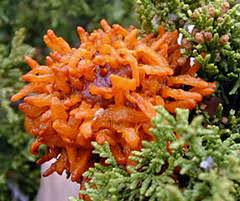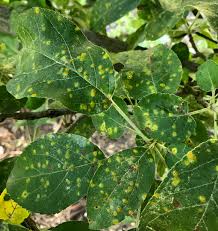Cedar apple rust is a fungal disease that requires juniper plants to complete its complicated two-year lifecycle. Spores overwinter as a reddish-brown gall on young twigs of various juniper species. In early spring, during wet weather, these galls swell, and bright orange masses of spores are blown by the wind where they infect susceptible apple and crab-apple trees. The spores that develop on these trees will only infect junipers the following year. From year to year, the disease must pass from junipers to apples to junipers again; it cannot spread between apple trees.

On apple and crab-apple trees, look for pale yellow pinhead sized spots on the upper surface of the leaves shortly after bloom. These gradually enlarge to bright orange-yellow spots which make the disease easy to identify. Orange spots may develop on the fruit as well. Heavily infected leaves may drop prematurely.

If your apple tree is prone to this disease, use an orchard fungicide spray or an all-purpose orchard spray. Some varieties immune to this disease are: Goldrush, Pristine, and Redfree.
